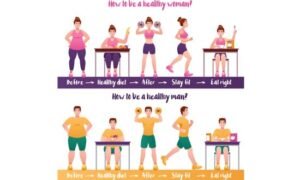When we aim to be healthier and fitter, a key focus is learning how to lower body fat percentage. It’s not just about looking better; it’s also about feeling better and being healthier. Here are 16 effective steps and tips to help you achieve a lower body fat percentage effectively and in a way that lasts. Let’s start your journey to a healthier you!
Understanding Body Fat Percentage
Before discussing the methods for lowering body fat percentage, it’s essential to understand what body fat percentage actually is. Body fat percentage refers to the proportion of your total body weight that is made up of fat. This percentage is an important indicator of your overall health and fitness level.
The Ideal Body Fat Percentage
The ideal body fat percentage varies from person to person, depending on factors such as age, gender, and fitness goals. Generally, for men, a healthy range falls between 10% to 20% body fat, while for women, it’s around 18% to 28%. Athletes tend to have even lower percentages, often between 6% and 13% for men and 14% to 20% for women.
Why Lowering Body Fat Percentage Matters?
Reducing body fat percentage offers a multitude of benefits, including:
- Improved Health
Lower body fat percentages are associated with a decreased risk of health issues like heart disease, diabetes, and high blood pressure.
- Enhanced Physical Performance
A lower body fat percentage can result in increased stamina and agility, making you perform better in physical activities and sports.
- Enhanced Aesthetics
Achieving a lower body fat percentage can result in a more toned and sculpted appearance, boosting your confidence.
How to Lower Body Fat Percentage?
Here are the 16 top strategies and steps you can take to reduce your body fat percentage effectively:
1. Stay Hydrated
A well-hydrated body functions better. Water aids in metabolism and helps control hunger. Make sure you’re drinking enough water throughout the day.
To keep track of your daily water intake and your body’s hydration status, check out our user friendly water intake calculator.
2. Get Sufficient Sleep
Aim for 7-9 hours of quality sleep per night. Inadequate sleep can lead to hormonal imbalances that make it harder to shed body fat.
3. Eat High Protein Diet
Foods like meat and eggs can help you feel full and satisfied, making it easier to cut calories and lose fat. Protein also supports muscle preservation during weight loss.
4. Eat Healthy Fats
Include sources like olive oil and nuts in your diet. These healthy fats may help with long-term weight loss and overall health. Avoid trans fats found in fried and processed foods.
5. Stop Using Sweetened Drinks
Replace sugary drinks with water or unsweetened green tea. Reducing liquid calories is an easy way to support fat loss.
6. Eat Fiber-Rich Foods
Consume fruits, vegetables, and whole grains to increase feelings of fullness. This can help control your calorie intake and promote weight loss.
7. Use Coffee for Boosting Metabolism
Coffee contains caffeine, which can boost metabolism and enhance fat breakdown. Drinking it black or with minimal additives is the healthiest option.
8. Prefer Whole Grains Over Refined Carbs
Opt for whole grains over refined carbs like white bread and pastries. Whole grains are higher in fiber and nutrients, making them a better choice for sustainable fat loss.
9. Do Cardio Exercises
Engage in activities like running, walking, or swimming. Cardio workouts help you burn calories and reduce belly fat. Aim for 150–300 minutes of moderate to vigorous exercise per week.
10. Try High Intensity Interval Training (HIIT) Workouts
High-Intensity Interval Training involves short bursts of intense exercise followed by rest periods. HIIT is highly effective for fat loss and can save time compared to traditional cardio.
11. Strength Training
Lift weights or do bodyweight exercises to reduce body fat and boost your metabolism. Building muscle helps you burn more calories, even at rest.
12. Probiotics Support
Probiotics are found in foods like yogurt and kimchi. Probiotics are useful in maintaining healthy gut bacteria. Adding these in your diet can aid in weight management. They may help reduce body weight and fat percentage.
13. Manage Stress
High stress levels can lead to weight gain. Practice stress-reduction techniques like meditation, yoga, or deep breathing exercises.
14. Try Intermittent Fasting
Alternating between eating and fasting periods can lead to significant weight and fat loss. Different fasting methods, such as the 16/8 approach, can be experimented with to find what suits your routine.
15. Monitor Your Progress
Keep a journal to track your food intake, exercise routines, and body measurements. Regularly reviewing your progress can help you make necessary adjustments.
16. Seek Professional Guidance
Consider consulting a nutritionist or personal trainer to create a personalized plan that suits your specific needs and goals.
Useful Tools for Weight Management
You can use our user friendly BMI calculator , BMR calculator and calories calculator to keep track of your weight in your weight management journey. Whether you’re aiming to maintain, lose, or gain weight, these tools provide valuable insights to help you stay on track and achieve your wellness goals effortlessly.
FAQ’s
- What is body fat percentage, and why is it important for my health?Your body fat percentage is the amount of fat in your body compared to the total weight. It’s essential for health because excess body fat can lead to various health issues, including heart disease and diabetes.
- How can I measure my current body fat percentage?You can measure your body fat percentage through methods like skinfold calipers, bioelectrical impedance scales, or DEXA scans. These techniques provide an accurate assessment of your current body fat levels.
- What’s the recommended body fat percentage, and how can I achieve it?The recommended body fat percentage varies by age and gender, but it generally ranges from 18% to 24% for women and 10% to 17% for men. To reach or maintain these levels, focus on a combination of a balanced diet and regular exercise.
- Can I target specific areas for fat loss, and if so, how?You can’t spot-reduce fat in specific areas, but you can lose overall body fat, which will eventually reduce fat in those trouble spots. To do this, follow a comprehensive fitness plan, including cardio and strength training.
- How to lower body fat percentage without extreme diets or excessive exercise?To lower body fat percentage effectively and sustainably, avoid extreme diets and excessive exercise. Instead, focus on a balanced, nutritious diet with a slight calorie deficit and a regular exercise routine that you enjoy. Slow, steady progress is the key to success.
For any further query feel free to contact us at https://medicalinquiries.com/contact-us/
Conclusion
Reducing your body fat percentage is an achievable goal with the right approach. Being slim and smart is not just about the outlook rather it will help you in living a healthier life. By following a balanced diet, exercising regularly and opting healthy habits in the lifestyle you can easily lower your body fat percentage. Consistence is the key in your journey towards fitness. Staying committed to your goals and making healthy choices will eventually lead to success.


